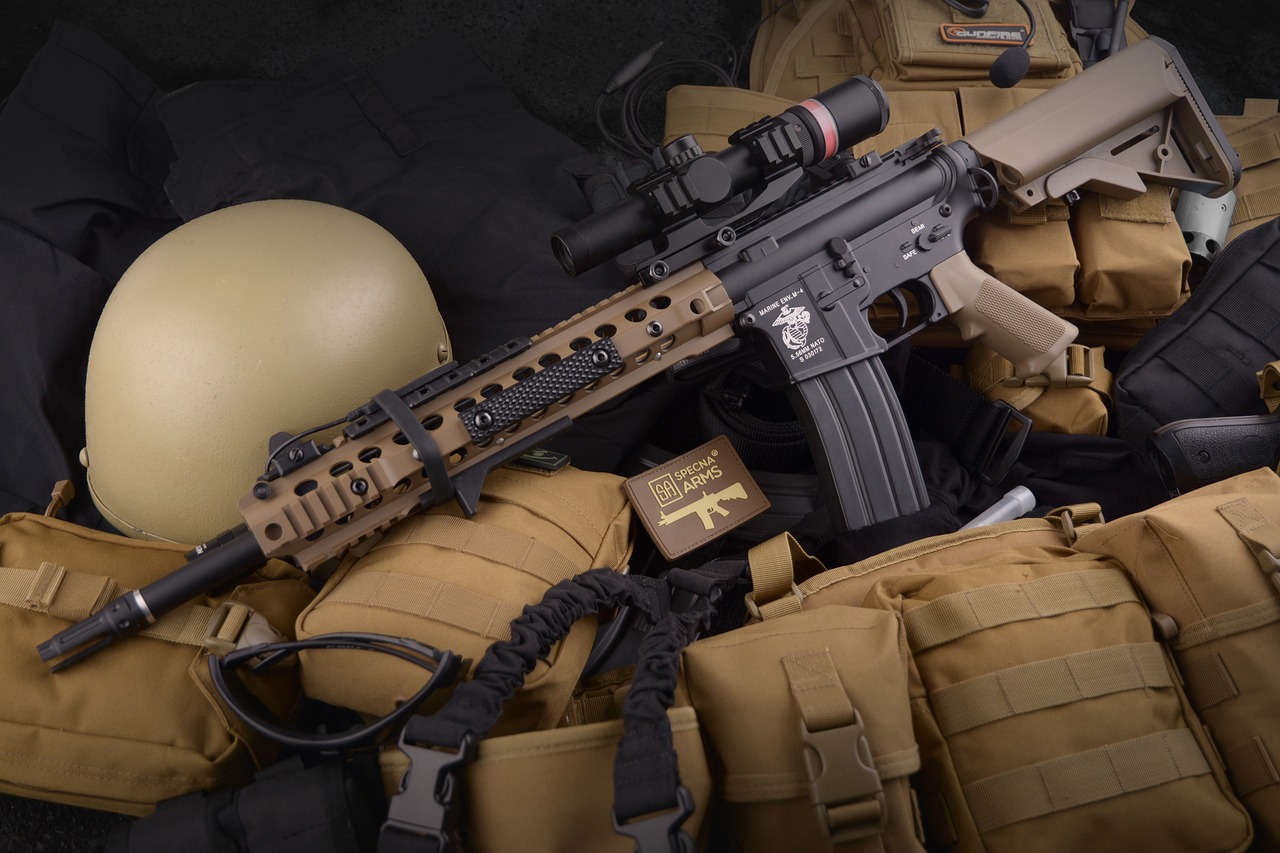Exploring AI-Driven Tactical Communication Networks
In today's fast-paced world, the integration of artificial intelligence (AI) into tactical communication networks is not just a trend; it's a transformative shift that is reshaping how military and emergency response teams operate. Imagine a battlefield where decisions are made in the blink of an eye, not just based on instinct but on data-driven insights. This is the reality that AI is creating, enhancing the way we communicate and respond in critical situations. The importance of swift and accurate communication cannot be overstated, especially when lives are on the line. With AI at the helm, we are witnessing a revolution that promises to enhance efficiency, effectiveness, and ultimately, success in operations.
The core of this transformation lies in the ability of AI to process enormous amounts of data quickly and accurately. Traditional communication methods often falter under the weight of information overload, leading to delays and miscommunication. In contrast, AI-driven systems can sift through data streams, identify relevant patterns, and present actionable insights in real-time. This capability is akin to having a highly skilled analyst working tirelessly to ensure that decision-makers have the most pertinent information at their fingertips. Whether it's a military operation or a natural disaster response, the ability to communicate effectively can mean the difference between success and failure.
Furthermore, the applications of AI in tactical communication extend beyond mere data analysis. With technologies such as machine learning and natural language processing (NLP), these networks are becoming more intuitive and user-friendly. Imagine a scenario where commanders can interact with their communication systems using natural language commands, eliminating the need for extensive training on complex software. This ease of use fosters a more agile and responsive environment, allowing teams to focus on what truly matters: the mission at hand.
However, the journey towards fully integrated AI-driven tactical communication networks is not without its challenges. Issues such as cybersecurity threats and data privacy concerns loom large, as the very technologies that enhance communication also create new vulnerabilities. As we embrace these advancements, it is crucial to address these challenges head-on to ensure that the systems we rely on are secure and trustworthy.
As we look to the future, the potential for AI to revolutionize tactical communication networks is immense. With the advent of 5G technology, we can expect faster data transmission and lower latency, making these networks even more effective in dynamic environments. Additionally, increased automation will streamline operations, reduce human error, and enhance overall efficiency. The future is bright for AI-driven tactical communication networks, and the possibilities are as exciting as they are transformative.
- What is AI's role in tactical communication? AI enhances communication by processing data quickly, enabling real-time decision-making, and optimizing resource allocation.
- What are the key technologies involved? Key technologies include machine learning, natural language processing, and edge computing.
- What challenges do AI communication networks face? Major challenges include cybersecurity risks, data privacy concerns, and the need for robust infrastructure.
- How will 5G technology impact tactical communication? 5G will provide faster data transmission and lower latency, improving the effectiveness of communication networks.

The Role of AI in Tactical Communication
Artificial Intelligence (AI) is not just a buzzword; it's a game-changer in the realm of tactical communication. Imagine being in a high-stakes environment where every second counts, and the ability to communicate effectively can mean the difference between success and failure. AI enhances tactical communication by improving data processing, enabling real-time decision-making, and optimizing resource allocation. This trio of benefits leads to more effective communication strategies in critical situations, whether on the battlefield or during emergency response scenarios.
One of the most significant advantages of AI in tactical communication is its ability to process vast amounts of data at lightning speed. In a world where information is constantly flowing, the ability to sift through this data and extract actionable insights is invaluable. For instance, AI algorithms can analyze patterns in communication traffic, identifying potential bottlenecks or failures before they occur. This proactive approach allows teams to adjust their strategies on-the-fly, ensuring that communication remains seamless and efficient.
Moreover, AI facilitates real-time decision-making by providing decision-makers with the most current intelligence available. Imagine a scenario where military personnel are engaged in a complex operation. Instead of waiting for reports to be compiled and disseminated, AI can deliver real-time updates from various sources—drones, sensors, and even social media—allowing commanders to make informed decisions almost instantaneously. This capability not only enhances situational awareness but also improves the overall effectiveness of operations.
Another critical aspect of AI in tactical communication is its role in optimizing resource allocation. In high-pressure situations, resources such as personnel, equipment, and communication bandwidth are often limited. AI can analyze the current operational landscape and suggest optimal deployment strategies, ensuring that resources are used where they are needed most. By doing so, it minimizes waste and maximizes impact, which is crucial in both military and emergency response contexts.
However, the integration of AI into tactical communication networks is not without its challenges. While the benefits are substantial, there are also concerns regarding cybersecurity and data privacy. As these AI systems become more sophisticated, they also become attractive targets for cyberattacks. Protecting sensitive information is paramount, and advanced security measures must be implemented to safeguard these communication networks. Furthermore, the collection and use of data must be handled with care to ensure that privacy is maintained, especially in operations that involve civilian populations.
In summary, AI is revolutionizing tactical communication by enhancing data processing, enabling real-time decision-making, and optimizing resource allocation. As we continue to explore the capabilities of AI in this domain, it is essential to address the associated challenges to fully leverage its potential. The future of tactical communication is bright, and AI is at the forefront of this transformation.
- What is the primary role of AI in tactical communication? AI enhances data processing, real-time decision-making, and resource allocation, improving overall communication effectiveness.
- How does AI improve situational awareness? By analyzing vast amounts of data quickly, AI provides timely insights that help decision-makers understand the current operational landscape.
- What are the cybersecurity concerns associated with AI in communication? As AI systems become more prevalent, they are attractive targets for cyberattacks, necessitating advanced security measures to protect sensitive information.
- How can AI optimize resource allocation? AI analyzes operational data to suggest optimal deployment strategies, ensuring resources are used efficiently in critical situations.

Key Technologies in AI-Driven Networks
In the rapidly evolving landscape of tactical communication networks, several key technologies stand out as the backbone of AI integration. These technologies not only enhance communication efficiency but also empower military and emergency response teams to make informed decisions in real time. Among these, machine learning, natural language processing (NLP), and edge computing play pivotal roles in shaping the future of tactical communications.
Machine learning is at the forefront of this transformation. By leveraging algorithms that can learn from and make predictions based on data, machine learning enables systems to analyze vast amounts of information quickly. This capability is crucial in tactical operations, where situational awareness can mean the difference between success and failure. For instance, machine learning algorithms can sift through data from various sources—such as satellite imagery, sensor readings, and social media feeds—to identify patterns that might indicate emerging threats or opportunities.
One of the most significant applications of machine learning in tactical networks is predictive analytics. By examining historical data, predictive analytics can forecast future events, allowing teams to prepare for potential challenges. Imagine a military unit anticipating a supply shortage based on past consumption patterns; this foresight enables them to allocate resources more effectively and avoid critical failures. Furthermore, real-time data processing is another area where machine learning shines. It allows for immediate analysis and dissemination of information, ensuring decision-makers have access to the most current intelligence during operations.
Another cornerstone technology is natural language processing (NLP). This technology facilitates seamless communication between humans and machines, breaking down language barriers and enabling intuitive interaction. In high-pressure scenarios, where every second counts, being able to communicate clearly and efficiently is invaluable. NLP can help translate data into understandable formats, making it easier for personnel to interpret and act on information swiftly. For example, a soldier could query a system in plain language and receive immediate, actionable insights, rather than wading through complex data sets.
Finally, edge computing is revolutionizing how data is processed and shared in tactical environments. By processing data closer to the source, edge computing reduces latency and bandwidth usage, which are critical in scenarios where every millisecond matters. This decentralized approach ensures that decision-makers receive the information they need without delay, even in remote or hostile environments. The synergy of these technologies creates a robust framework for AI-driven tactical communication networks that are not only efficient but also resilient.
| Technology | Role in Tactical Communication |
|---|---|
| Machine Learning | Analyzes data to predict outcomes and improve situational awareness. |
| Natural Language Processing | Facilitates intuitive human-machine communication. |
| Edge Computing | Processes data closer to the source for real-time analysis. |
As we look to the future, the integration of these technologies will only deepen, leading to more sophisticated and effective tactical communication networks. The landscape of military and emergency response operations is changing, and those who harness the power of AI-driven networks will undoubtedly gain a strategic advantage.
- What is tactical communication? Tactical communication refers to the systems and methods used by military and emergency responders to share information quickly and effectively in critical situations.
- How does AI improve tactical communication? AI enhances tactical communication by enabling faster data processing, real-time decision-making, and optimizing resource allocation.
- What are the main technologies driving AI in tactical networks? The main technologies include machine learning, natural language processing, and edge computing.

Machine Learning Applications
When we talk about machine learning in the context of tactical communication networks, we’re diving into a realm where data becomes a powerful ally. Imagine having the capability to sift through mountains of data in mere seconds, identifying patterns and predicting outcomes that can be crucial in high-stakes environments. This is precisely what machine learning offers—an unparalleled edge in enhancing situational awareness and expediting response times in tactical operations.
One of the most compelling applications of machine learning is its ability to analyze historical data to inform future actions. For instance, during military operations, machine learning algorithms can evaluate past engagements to identify successful strategies and potential pitfalls. This predictive capability not only aids in planning but also empowers teams to adapt swiftly to evolving situations on the ground. By leveraging predictive analytics, commanders can anticipate challenges before they arise, ensuring that resources are allocated effectively.
Moreover, the beauty of machine learning lies in its real-time data processing capabilities. Imagine a scenario where a tactical unit is operating in a rapidly changing environment, such as a natural disaster or a combat zone. With real-time data processing, information from various sources—drones, sensors, and ground troops—can be analyzed instantaneously. This ensures that decision-makers are equipped with the most current intelligence, allowing for timely and informed decisions that can save lives and enhance mission success rates.
To illustrate the impact of machine learning in tactical communication, consider the following table that summarizes key applications:
| Application | Description | Benefits |
|---|---|---|
| Predictive Analytics | Analyzes historical data to forecast future events. | Enhances planning and resource allocation. |
| Real-time Data Processing | Processes data as it comes in for immediate insights. | Improves situational awareness and decision-making. |
| Pattern Recognition | Identifies trends and anomalies in data. | Facilitates proactive measures and strategies. |
In conclusion, the integration of machine learning into tactical communication networks is not just a technological advancement; it’s a game-changer. By enhancing situational awareness and enabling real-time responses, machine learning transforms the way military and emergency response teams operate. As we continue to explore and refine these technologies, the potential for improved outcomes in critical situations becomes not only a possibility but a reality.
- What is machine learning?
Machine learning is a subset of artificial intelligence that focuses on the development of algorithms that allow computers to learn from and make predictions based on data.
- How does machine learning improve tactical communication?
Machine learning enhances tactical communication by providing predictive analytics, real-time data processing, and pattern recognition, which all contribute to better situational awareness and quicker decision-making.
- What are some challenges associated with machine learning in tactical communication?
Challenges include data privacy concerns, the need for robust infrastructure, and cybersecurity risks that arise from increased reliance on AI technologies.

Predictive Analytics
Predictive analytics is like having a crystal ball for military and emergency response teams. By leveraging historical data and advanced algorithms, this technology enables organizations to forecast potential future events with remarkable accuracy. Imagine being able to anticipate a storm before it hits or predicting the movements of adversaries before they even make a move. This capability is not just a luxury; it’s a necessity in tactical communication networks where every second counts.
At its core, predictive analytics involves analyzing patterns from past data to identify trends and make informed decisions. For instance, when a natural disaster strikes, predictive models can analyze previous incidents to determine the most likely areas to be affected, allowing teams to allocate resources efficiently and effectively. This proactive approach can save lives and minimize damage, highlighting the critical role of predictive analytics in modern operations.
Moreover, the integration of predictive analytics into tactical communication systems can enhance operational readiness. By using real-time data from various sources, such as weather reports, social media feeds, and sensor data, teams can receive timely alerts about emerging threats or opportunities. This capability not only improves situational awareness but also empowers decision-makers to act swiftly, ensuring that they are always one step ahead of the curve.
To illustrate the impact of predictive analytics, consider the following table, which outlines key benefits:
| Benefit | Description |
|---|---|
| Enhanced Decision-Making | Provides data-driven insights that help leaders make informed choices quickly. |
| Resource Optimization | Enables efficient allocation of resources based on predicted needs and scenarios. |
| Improved Response Times | Allows teams to react faster to changing situations by anticipating developments. |
| Risk Mitigation | Identifies potential risks before they escalate, allowing for preventive measures. |
In conclusion, predictive analytics is revolutionizing the way military and emergency response teams operate. By harnessing the power of data, organizations can not only anticipate challenges but also seize opportunities that may arise in high-pressure situations. As technology continues to evolve, the potential for predictive analytics in tactical communication networks will only grow, making it an indispensable tool for those on the front lines.
- What is predictive analytics? Predictive analytics is a technology that uses historical data and algorithms to forecast future events and trends.
- How does predictive analytics improve tactical communication? It enhances decision-making, optimizes resource allocation, and improves response times by anticipating challenges.
- What types of data are used in predictive analytics? Various data sources, including historical incident data, real-time sensor data, and social media feeds, can be utilized.
- Are there any risks associated with predictive analytics? While predictive analytics offers many benefits, it also raises concerns regarding data privacy and the accuracy of predictions.

Real-time Data Processing
In the fast-paced world of tactical communication, is nothing short of a game-changer. Imagine being in a high-stakes situation where every second counts; the ability to analyze and disseminate information instantly can mean the difference between success and failure. Real-time data processing enables military and emergency response teams to receive and interpret critical information as it happens, allowing for swift decision-making and action.
At the core of this technology is the capacity to handle vast amounts of data from various sources, including sensors, satellites, and communication devices. This data is processed on-the-fly, ensuring that teams have access to the most current intelligence. For instance, during a natural disaster, real-time data processing can help responders understand the evolving situation, identify areas in need of immediate assistance, and allocate resources efficiently. The implications are profound: faster response times can save lives and mitigate damage.
Furthermore, the integration of artificial intelligence with real-time data processing enhances the system's capability. AI algorithms can sift through incoming data streams, identifying patterns and anomalies that human operators might miss. This not only improves situational awareness but also equips decision-makers with predictive insights that drive proactive measures. For example, in a military operation, real-time data processing coupled with AI can alert commanders to potential threats before they materialize, allowing for preemptive actions.
To illustrate the significance of real-time data processing, consider the following table that outlines its key benefits:
| Benefit | Description |
|---|---|
| Speed | Instantaneous access to critical information enhances response times. |
| Accuracy | Real-time analysis reduces the likelihood of human error in decision-making. |
| Predictive Capabilities | AI-driven insights allow for anticipating challenges and proactive planning. |
| Resource Optimization | Efficient allocation of resources based on real-time needs and conditions. |
In conclusion, the power of real-time data processing in tactical communication networks cannot be overstated. It not only streamlines operations but also enhances the overall effectiveness of military and emergency response efforts. As technology continues to evolve, the integration of AI and real-time data processing will undoubtedly lead to even more sophisticated systems that keep us prepared for any challenge that lies ahead.
- What is real-time data processing?
Real-time data processing refers to the immediate analysis and interpretation of data as it is generated, allowing for quick decision-making and response. - How does AI enhance real-time data processing?
AI algorithms can analyze large volumes of data quickly, identifying patterns and insights that aid in timely decision-making. - What are the applications of real-time data processing?
It is widely used in military operations, emergency response, disaster management, and various industries where timely information is critical.

Natural Language Processing
Natural Language Processing, or NLP, is a fascinating field that bridges the gap between human communication and computer understanding. Imagine having a conversation with a machine that not only understands your words but can also grasp the nuances and emotions behind them. That’s the power of NLP in tactical communication networks. It transforms the way military and emergency responders interact with technology, making communication more intuitive and efficient.
In tactical scenarios, where every second counts, clear and concise communication is paramount. NLP enables systems to process and analyze human language, allowing for seamless interactions between operators and AI systems. For example, consider a scenario where a commander issues a command in natural language. With NLP, the system can interpret this command, translate it into actionable data, and relay it to the relevant units without the need for complex coding or jargon. This not only speeds up the communication process but also minimizes the potential for misunderstandings that could have dire consequences.
The applications of NLP in tactical communication networks are vast and varied. Here are a few key functionalities that highlight its importance:
- Speech Recognition: NLP systems can convert spoken language into text, allowing for real-time transcription of critical communications.
- Sentiment Analysis: By analyzing the emotional tone of communications, NLP can help teams gauge the morale of personnel and adjust strategies accordingly.
- Contextual Understanding: NLP can understand the context of messages, which is crucial in high-stakes environments where the meaning of words can change based on the situation.
Moreover, the integration of NLP into tactical communication networks enhances collaboration among team members. By enabling systems to understand and process requests in natural language, teams can focus on their mission rather than getting bogged down by technical jargon. This is particularly beneficial in joint operations where multiple teams from different backgrounds must communicate effectively.
However, as with any technology, the implementation of NLP is not without its challenges. There are concerns regarding language ambiguity, dialect variations, and the need for extensive training data to improve accuracy. Nonetheless, ongoing advancements in machine learning and linguistic research are paving the way for more robust NLP systems that can handle the complexities of human language with greater precision.
In summary, Natural Language Processing is revolutionizing tactical communication networks by making interactions between humans and machines more fluid and efficient. As this technology continues to evolve, we can expect even greater enhancements in how military and emergency response teams communicate, collaborate, and execute their missions effectively.
- What is Natural Language Processing?
NLP is a field of artificial intelligence that focuses on the interaction between computers and humans through natural language.
- How does NLP improve tactical communication?
NLP enhances tactical communication by allowing systems to understand and process human language, facilitating faster and clearer interactions.
- What are the main applications of NLP in tactical networks?
Main applications include speech recognition, sentiment analysis, and contextual understanding, all of which improve operational efficiency.
- What challenges does NLP face?
Challenges include language ambiguity, dialect variations, and the need for extensive training data to enhance accuracy.

Challenges in Implementing AI Communication Networks
Integrating artificial intelligence into tactical communication networks is not just a walk in the park. While the benefits are clear and compelling, the road to implementation is fraught with challenges that can make even the most seasoned professionals scratch their heads. One of the primary hurdles is the looming threat of cybersecurity risks. As AI systems become more sophisticated, they also attract the attention of cybercriminals looking to exploit vulnerabilities. This necessitates the development of advanced security measures that can protect sensitive information from potential breaches. Imagine a high-stakes game of chess where each move must be calculated not just for winning but also for defending against a cunning opponent.
Moreover, data privacy concerns are another significant challenge. With the integration of AI, vast amounts of data are collected, analyzed, and stored. This raises important questions about how this data is handled. Are we doing enough to secure personal information? How is the data being used? These questions are not just technical; they touch on ethical considerations that demand our attention. The balance between leveraging data for operational efficiency and protecting individual privacy is a tightrope walk that requires careful planning and execution.
Additionally, the need for a robust infrastructure cannot be overstated. AI-driven communication networks rely heavily on advanced technologies that require significant investment in both hardware and software. Without a solid foundation, these systems can become fragile, leading to failures in critical moments. It’s akin to building a skyscraper on a shaky foundation; no matter how impressive the structure, it’s only as strong as what lies beneath.
Furthermore, the integration of AI into existing systems poses its own set of challenges. Many organizations may find their current communication networks incompatible with new AI technologies. This can lead to increased costs and extended timelines for implementation. The transition requires not only new tools but also training for personnel to effectively use these technologies. It's like upgrading from a bicycle to a high-speed motorcycle; you need to learn how to handle the new ride before you can take it out for a spin.
In summary, while the potential of AI in tactical communication networks is immense, the challenges of cybersecurity, data privacy, infrastructure needs, and integration with existing systems must be addressed head-on. Overcoming these hurdles will not only improve the effectiveness of communication strategies but also ensure that these systems are safe, secure, and reliable in times of crisis.
- What are the main cybersecurity risks associated with AI communication networks?
The main risks include data breaches, unauthorized access, and potential manipulation of AI systems by cybercriminals. - How can organizations ensure data privacy in AI systems?
Organizations can implement stringent data governance policies, encryption techniques, and regular audits to safeguard personal information. - What infrastructure is needed for AI-driven communication networks?
A robust infrastructure typically includes high-speed internet, advanced servers, and secure data storage solutions. - How can organizations facilitate the integration of AI into existing systems?
By conducting thorough assessments of current systems, investing in training, and gradually phasing in new technologies, organizations can streamline the integration process.

Cybersecurity Risks
In the rapidly evolving landscape of AI-driven tactical communication networks, have emerged as a paramount concern. As these systems become more integrated into military and emergency response operations, they also become increasingly attractive targets for cybercriminals and hostile entities. The sophistication of cyberattacks is continually advancing, and the potential consequences of a successful breach are dire. Imagine a scenario where critical communication lines are compromised during a military operation—this could lead to catastrophic failures in strategy and execution.
One of the primary risks associated with AI systems is their reliance on vast amounts of data. This data not only fuels machine learning algorithms but also contains sensitive information about personnel, strategies, and operational plans. If this data falls into the wrong hands, it could be exploited for malicious purposes. Furthermore, the interconnected nature of these networks means that a single vulnerability can serve as a gateway for attackers to infiltrate an entire system.
To combat these risks, organizations must adopt a multi-faceted approach to cybersecurity. Here are some critical strategies:
- Regular Security Audits: Conducting frequent assessments of the system can help identify vulnerabilities before they are exploited.
- Advanced Encryption Techniques: Utilizing state-of-the-art encryption can protect data both in transit and at rest, ensuring that even if data is intercepted, it remains unreadable.
- Employee Training: Human error is often the weakest link in cybersecurity. Regular training can equip personnel with the knowledge to recognize and respond to potential threats.
- Incident Response Plans: Having a well-defined response plan in place can significantly reduce the impact of a cyberattack when it occurs.
Moreover, the dynamic nature of AI technologies means that cybersecurity measures must also evolve. This includes leveraging AI itself to enhance security protocols. For instance, machine learning can be employed to detect anomalies in network traffic, flagging potential intrusions before they escalate into serious threats. As we continue to push the boundaries of what AI can achieve, integrating robust cybersecurity measures will be essential to safeguard tactical communication networks.
Q: What are the main cybersecurity risks associated with AI-driven tactical communication networks?
A: The primary risks include data breaches, unauthorized access to sensitive information, and the exploitation of system vulnerabilities. These risks can lead to significant operational failures and compromised security.
Q: How can organizations protect their AI systems from cyberattacks?
A: Organizations can implement regular security audits, utilize advanced encryption techniques, conduct employee training, and establish incident response plans to mitigate risks.
Q: Why is employee training important in cybersecurity?
A: Human error often leads to security breaches. Training employees helps them recognize potential threats and respond appropriately, reducing the likelihood of successful cyberattacks.
Q: Can AI be used to enhance cybersecurity?
A: Yes, AI can analyze network traffic for anomalies and detect potential intrusions, providing a proactive layer of security to protect against cyber threats.

Data Privacy Concerns
The integration of artificial intelligence in tactical communication networks has ushered in a new era of efficiency and responsiveness. However, it also brings forth significant that cannot be overlooked. As these systems collect and process vast amounts of sensitive information, the question arises: how do we ensure that this data remains secure and private?
Firstly, it's important to understand what types of data are at risk. Tactical communication networks often handle information related to military operations, emergency responses, and personal data of individuals involved in these scenarios. This sensitive information can include:
- Location Data: Tracking the movements of personnel and assets.
- Communication Logs: Records of conversations and messages exchanged.
- Personal Identifiable Information (PII): Data that can be used to identify individuals.
With the rise of AI technologies, the methods of data collection and analysis have become more sophisticated, which unfortunately also means that vulnerabilities can be exploited. Cybercriminals are constantly developing new strategies to breach systems, making it crucial for organizations to implement robust security measures. For instance, encryption protocols and secure access controls are essential to protect sensitive data from unauthorized access.
Moreover, the ethical implications of data usage in AI-driven systems are a pressing concern. Organizations must navigate the fine line between leveraging data for operational efficiency and respecting the privacy rights of individuals. This involves establishing clear guidelines on how data is collected, stored, and utilized. Transparency is key; stakeholders should be informed about what data is being collected and for what purposes.
To address these concerns, many organizations are adopting frameworks that prioritize data privacy and compliance with regulations such as the General Data Protection Regulation (GDPR). This not only helps in safeguarding sensitive information but also builds trust among users and stakeholders. After all, in a world increasingly driven by data, maintaining privacy can be seen as a fundamental right.
In conclusion, while AI-driven tactical communication networks offer numerous advantages, the associated data privacy concerns must be addressed proactively. Implementing stringent security measures, ensuring transparency, and adhering to regulatory standards are essential steps in creating a secure environment where data can be utilized effectively without compromising individual privacy.
- What types of data are most vulnerable in tactical communication networks?
Tactical communication networks handle sensitive information such as location data, communication logs, and personal identifiable information (PII), all of which are at risk of unauthorized access. - How can organizations ensure data privacy in AI systems?
Organizations can ensure data privacy by implementing robust security measures, such as encryption, secure access controls, and adhering to privacy regulations like GDPR. - What is the role of transparency in data privacy?
Transparency is crucial as it informs stakeholders about what data is being collected and how it will be used, helping to build trust and ensure ethical data practices.

Future Trends in Tactical Communication
As we peer into the crystal ball of tactical communication, it's clear that the landscape is evolving at a breathtaking pace. The future is not just about incremental improvements; it's about a **paradigm shift** that will redefine how military and emergency response teams operate. One of the most significant trends on the horizon is the advent of 5G technology. This next-generation network promises to revolutionize communication by providing faster data transmission and lower latency. Imagine being able to share high-definition video feeds or critical intelligence in real-time, without the frustrating lag that can often hinder decision-making in critical situations. With 5G, tactical teams will be equipped with the tools to act swiftly and effectively, responding to threats before they escalate.
Moreover, the integration of increased automation into tactical communication systems is set to streamline operations like never before. Just think about it: by automating routine tasks and processes, teams can reduce human error and focus their energies on what truly matters—making critical decisions that can save lives. This level of efficiency is akin to having a well-oiled machine where every cog and wheel works in perfect harmony, allowing for seamless communication and coordination.
Another exciting trend is the push for enhanced interoperability among various communication systems. In the past, different agencies and branches of the military often operated on separate platforms, leading to a fragmented communication landscape. However, the future is geared towards creating systems that can communicate with one another effortlessly. This interoperability will enable teams from different backgrounds to work together more effectively, sharing vital information and resources without the barriers that previously existed. Imagine a scenario where police, fire, and military units can coordinate their efforts in real-time, all thanks to a unified communication framework.
As these technologies converge, we can expect to see a more **resilient** and **efficient** tactical communication network. However, it's essential to remain vigilant about the challenges that accompany these advancements. With increased connectivity comes increased vulnerability to cybersecurity threats, which will require robust measures to safeguard sensitive information. As the saying goes, “with great power comes great responsibility.” The responsibility now lies with developers, operators, and policymakers to ensure that the benefits of these technologies are fully realized while mitigating potential risks.
In summary, the future of tactical communication is bright and full of promise. With innovations like 5G technology, increased automation, and enhanced interoperability, we are on the cusp of a communication revolution that will empower military and emergency response teams to operate with unprecedented effectiveness. But as we embrace these advancements, we must also remain aware of the challenges ahead, ensuring that our systems are not only advanced but also secure and reliable.
- What is the role of 5G technology in tactical communication?
5G technology enhances tactical communication by providing faster data transmission and lower latency, enabling real-time sharing of critical information. - How does automation improve tactical communication?
Automation reduces human error and streamlines operations, allowing teams to focus on critical decision-making tasks without being bogged down by routine processes. - Why is interoperability important in tactical communication?
Enhanced interoperability allows different agencies and branches of the military to communicate seamlessly, improving coordination and response efforts during emergencies.

5G Technology Impact
The advent of 5G technology is set to revolutionize tactical communication networks in ways we could only dream of a few years ago. Imagine a world where military operations and emergency responses are executed with lightning speed and unparalleled efficiency. With 5G, this is not just a fantasy; it's becoming a reality. The enhanced bandwidth and reduced latency that come with 5G technology are crucial for the success of AI-driven communication systems. These improvements mean that information can be transmitted almost instantaneously, allowing teams to make decisions based on real-time data.
One of the most significant impacts of 5G is its ability to support a massive number of devices simultaneously. In tactical environments, where every second counts, the ability to connect multiple sensors, drones, and communication devices without lag can be a game-changer. Picture a battlefield where drones are relaying live footage, ground troops are receiving updates in real-time, and command centers are processing data from various sources—all at once. This interconnectedness not only enhances situational awareness but also increases operational effectiveness.
Moreover, the low latency of 5G networks allows for more sophisticated applications of machine learning and artificial intelligence. For instance, predictive analytics can be performed on-the-fly, providing teams with insights that were previously only available after significant delays. This means that military and emergency response teams can anticipate threats and allocate resources more efficiently, leading to improved outcomes in critical situations.
To better understand the impact of 5G technology on tactical communication, consider the following table that outlines key benefits:
| Benefit | Description |
|---|---|
| High Speed | Faster data transmission allows for real-time communication and decision-making. |
| Low Latency | Minimal delay in data exchange enhances responsiveness in tactical operations. |
| Massive Device Connectivity | Enables simultaneous connections for multiple devices, improving operational coordination. |
| Enhanced Data Processing | Supports advanced analytics and AI applications, leading to better situational awareness. |
However, while the benefits of 5G technology are immense, it is essential to address the challenges that accompany its implementation. Issues such as infrastructure readiness, cybersecurity risks, and the need for robust training programs for personnel must be carefully managed. As we embrace this new technology, we must also ensure that our systems are secure and our teams are prepared to leverage these advancements effectively.
In conclusion, the impact of 5G technology on tactical communication networks cannot be overstated. It promises to create a more connected, responsive, and efficient operational environment, ultimately leading to better outcomes in military and emergency response scenarios. As we move forward, the integration of 5G with AI-driven systems will likely set a new standard for how we communicate and operate in critical situations.
- What is 5G technology?
5G technology is the fifth generation of mobile network technology, offering faster data speeds, lower latency, and the ability to connect more devices simultaneously. - How does 5G enhance tactical communication?
5G enhances tactical communication by providing real-time data transmission, improving situational awareness, and enabling advanced AI applications. - What are the challenges of implementing 5G in tactical environments?
Challenges include infrastructure readiness, cybersecurity risks, and the need for adequate training for personnel.

Increased Automation
In the realm of tactical communication, is not just a buzzword; it's a game-changer. Imagine a world where communication systems operate with minimal human intervention, allowing teams to focus on what truly matters—strategic decision-making. Automation streamlines processes, reduces the likelihood of human error, and enhances the overall efficiency of operations. By integrating advanced algorithms and AI technologies, tactical communication networks can autonomously manage data flow, prioritize tasks, and even execute responses based on predefined criteria.
For instance, consider a military unit operating in a high-stakes environment. With automated systems, the communication network can instantly analyze incoming data from various sources—such as drones, sensors, and ground troops—and determine the most critical information to relay to commanders. This not only speeds up the decision-making process but also ensures that the information is accurate and timely. The impact of automation can be profound, as it allows personnel to concentrate on analyzing data and strategizing rather than getting bogged down in routine tasks.
Moreover, automation can facilitate seamless interoperability among different communication systems. In joint operations where multiple branches of the military or various emergency response teams must collaborate, automated systems can ensure that everyone is on the same page. By automatically translating and routing messages between different platforms, the risk of miscommunication is significantly reduced. This capability is vital in scenarios where every second counts, such as during a natural disaster response or a military engagement.
However, while the benefits of automation are clear, it's essential to approach its implementation thoughtfully. The transition to automated systems requires robust infrastructure and ongoing training for personnel to adapt to new technologies. Ensuring that all team members are comfortable with automated tools is crucial for maximizing their potential. Additionally, as automation increases, so does the importance of cybersecurity measures to protect these systems from potential threats. After all, a highly automated network is only as strong as its weakest link.
In summary, increased automation in tactical communication networks not only enhances efficiency but also empowers teams to make informed decisions swiftly. As we continue to embrace these technologies, the future of tactical operations looks promising, paving the way for a more responsive and effective communication landscape.
- What is the main benefit of increased automation in tactical communication?
Increased automation enhances efficiency, reduces human error, and allows teams to focus on critical decision-making tasks. - How does automation improve interoperability in joint operations?
Automation facilitates seamless communication between different systems, ensuring that all parties receive accurate and timely information. - What challenges come with implementing automated systems?
Challenges include the need for robust infrastructure, ongoing training for personnel, and enhanced cybersecurity measures to protect against threats.
Frequently Asked Questions
- What is the role of AI in tactical communication networks?
AI plays a crucial role in enhancing tactical communication by improving data processing capabilities, enabling real-time decision-making, and optimizing resource allocation. This leads to more effective communication strategies, especially in critical situations where every second counts.
- What key technologies are involved in AI-driven tactical communication?
Key technologies include machine learning, natural language processing (NLP), and edge computing. These technologies work together to analyze vast amounts of data, facilitate intuitive human-machine interaction, and ensure efficient data processing, making communication systems smarter and more responsive.
- How does machine learning improve tactical operations?
Machine learning enhances tactical operations by analyzing historical data to identify patterns and predict outcomes. This predictive capability significantly improves situational awareness and response times, allowing teams to anticipate challenges and allocate resources more effectively.
- What are the cybersecurity risks associated with AI in communication networks?
As AI systems become more integrated into communication networks, they also become attractive targets for cyberattacks. This necessitates the implementation of advanced security measures to protect sensitive information and ensure the integrity of communication channels.
- What future trends are expected in tactical communication?
Future trends include the adoption of 5G technology, which promises faster data transmission and lower latency, as well as increased automation. These advancements will make tactical communication networks more resilient, efficient, and capable of handling complex operations in dynamic environments.
- How does natural language processing enhance tactical communication?
Natural language processing (NLP) facilitates seamless communication between humans and machines. By enabling intuitive interaction, NLP enhances the usability of tactical communication systems, allowing users to engage with technology more effectively.
- What challenges arise from integrating AI into tactical communication networks?
Challenges include cybersecurity threats, data privacy concerns, and the need for robust infrastructure. These issues require careful consideration and strategic planning to ensure that the benefits of AI are realized without compromising security or privacy.



















